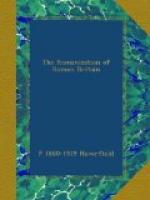No other Romano-British town has been excavated so extensively or so scientifically as Silchester. None, therefore, has yielded so much evidence. But we have no reason to consider Silchester exceptional in its character. Such scraps as we possess from other sites point to similar Romanization elsewhere. FVR, for instance, recurs on a potsherd from the Romano-British country town at Dorchester in Dorset. A set of tiles dug up in the ruins of a country-house at Plaxtol, in Kent, bear a Roman inscription impressed by a rude wooden stamp (Fig. 6).[1] In short, all the graffiti on potsherds or tiles that are known to me as found in towns or country-houses are equally Roman. Larger inscriptions, cut on stone, have also been found in country-houses. On the whole the general result is clear. Latin was employed freely in the towns of Britain, not only on serious occasions or by the upper classes, but by servants and work-people for the most accidental purposes. It was also used, at least by the upper classes, in the country. Plainly there did not exist in the towns that linguistic gulf between upper class and lower class which can be seen to-day in many cities of eastern Europe, where the employers speak one language and the employed another. On the other hand, it is possible that a different division existed, one which is perhaps in general rarer, but which can, or could, be paralleled in some Slavonic districts of Austria-Hungary. That is, the townsfolk of all ranks and the upper class in the country may have spoken Latin, while the peasantry may have used Celtic. No actual evidence has been discovered to prove this. We may, however, suggest that it is not, in itself, an impossible or even an improbable linguistic division of Roman Britain, even though the province did not contain any such racial differences as those of German, Pole, Ruthene and Rouman which lend so much interest to Austrian towns like Czernowitz.
[Footnote 1: Proc. Soc. Antiq. London, xxiii. 108; Eph. ix. 1290.]
[Illustration: FIG. 6. FRAGMENT OF INSCRIBED TILE FROM PLAXTOL AND RECONSTRUCTION OF THE INSCRIPTION FROM VARIOUS FRAGMENTS. (The letters were impressed by a wooden cylinder with incised lettering, which was rolled over the tile while still soft. In the reconstruction CAB in line 2 and IT in line 3 are included twice, to show the method of repetition.)]
It remains to cite the literary evidence, distinct if not abundant, as to the employment of Latin in Britain. Agricola, as is well known, encouraged the use of it, with the result (says Tacitus) that the Britons, who had hitherto hated and refused the foreign tongue, became eager to speak it fluently. About the same time Plutarch, in his tract on the cessation of oracles, mentions one Demetrius of Tarsus, grammarian, who had been teaching in Britain (A.D. 80), and mentions him as nothing at all out of the ordinary course.[1] Forty years later, Juvenal alludes casually to British lawyers taught by Gaulish schoolmasters. It is plain that by the second century Latin must have been spreading widely in the province. We need not feel puzzled about the way in which the Callevan workman of perhaps the third or fourth century learnt his Latin.




